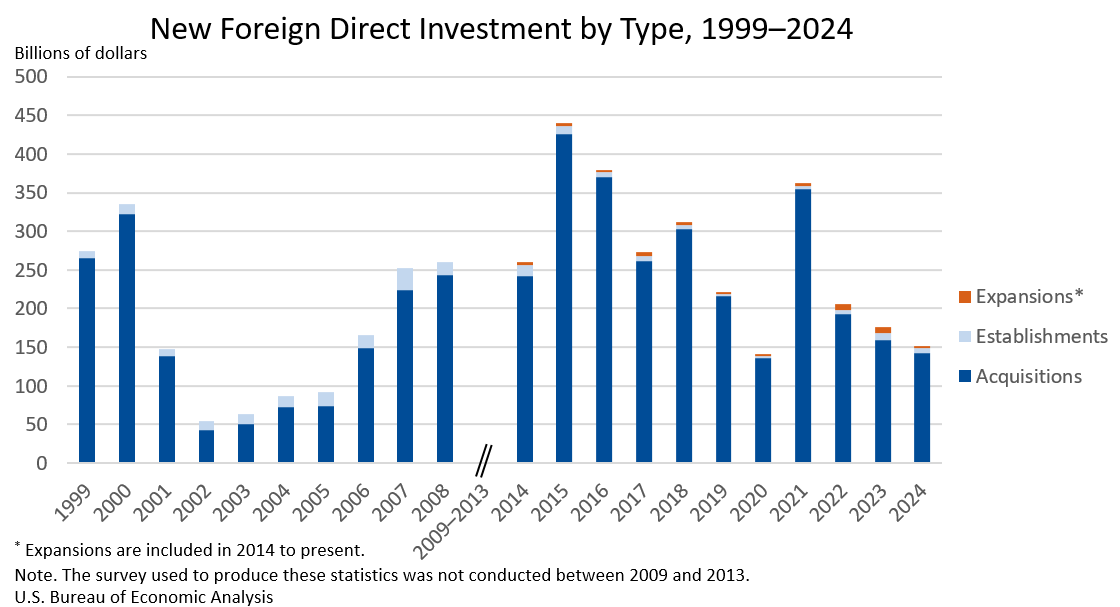Bureau of Economic Analysis
New Foreign Direct Investment in the United States, 2024
Expenditures by foreign direct investors to acquire, establish, or expand U.S. businesses totaled $151.0 billion in 2024, according to preliminary statistics released today by the U.S. Bureau of Economic Analysis. Expenditures decreased $24.9 billion, or 14.2 percent, from $176.0 billion (revised) in 2023 and were below the annual average of $277.2 billion for 2014–2023. As in previous years, acquisitions of existing U.S. businesses accounted for most of the expenditures.
Principal Federal Economic Indicators
Noteworthy
- 2025 News Release Schedule
- Innovation at BEA
- 2025 Annual Updates
- New! Services Trade Data for More Countries
- Data Tool: Trade in Value Added
- Distribution of State Personal Income
- Updated: RIMS II Regional Multipliers
- Arts and Culture
- Space Economy
- FDI Now in State BEARFACTS
- Quick Guide: Price Indexes
The Latest
Gross Domestic Product by State and Personal Income by State, 1st Quarter 2023
Real gross domestic product (GDP) increased in all 50 states and the District of Columbia in the first quarter of 2023, with the percent change in real GDP ranging from 12.4 percent in North Dakota to 0.1 percent in Rhode Island and Alabama. Personal income, in current dollars, increased in 48 states and the District of Columbia in the first quarter, with the percent change ranging from 11.4 percent in Maine to –1.0 percent in Indiana.
Personal Income and Outlays, May 2023
Personal income increased $91.2 billion (0.4 percent at a monthly rate) in May. Disposable personal income —personal income less personal current taxes— increased $86.7 billion (0.4 percent). Personal outlays—the sum of personal consumption expenditures, personal interest payments, and personal current transfer payments—increased $22.7 billion (0.1 percent) and consumer spending increased $18.9 billion (0.1 percent). Personal saving was $910.…
Personal Income and Outlays, May 2023
Personal income increased $91.2 billion (0.4 percent at a monthly rate) in May. Disposable personal income (DPI)—personal income less personal current taxes— increased $86.7 billion (0.4 percent). Personal outlays—the sum of personal consumption expenditures, personal interest payments, and personal current transfer payments—increased $22.7 billion (0.1 percent) and consumer spending increased $18.9 billion (0.1 percent). Personal saving was $…
Gross Domestic Product (Third Estimate), Corporate Profits (Revised Estimate), and GDP by Industry, First Quarter 2023
Real gross domestic product (GDP) increased at an annual rate of 2.0 percent in the first quarter of 2023, according to the “third” estimate. In the fourth quarter of 2022, real GDP increased 2.6 percent. The GDP estimate for the first quarter was revised up 0.7 percentage point from the “second” estimate, primarily reflecting upward revisions to exports and consumer spending.
Gross Domestic Product (Third Estimate), Corporate Profits (Revised Estimate), and GDP by Industry, First Quarter 2023
Real gross domestic product (GDP) increased at an annual rate of 2.0 percent in the first quarter of 2023, according to the “third” estimate. In the fourth quarter of 2022, real GDP increased 2.6 percent. The GDP estimate for the first quarter was revised up 0.7 percentage point from the “second” estimate, primarily reflecting upward revisions to exports and consumer spending. Profits decreased 4.1 percent at a quarterly rate in the first…
U.S. International Investment Position, 1st Quarter 2023 and Annual Update
The U.S. net international investment position, the difference between U.S. residents’ foreign financial assets and liabilities, was –$16.75 trillion at the end of first quarter of 2023, according to statistics released today by the U.S. Bureau of Economic Analysis (BEA). Assets totaled $32.74 trillion, and liabilities were $49.49 trillion. At the end of the fourth quarter of 2022, the net investment position was –$16.17 trillion (revised).
U.S. International Investment Position, 1st Quarter 2023
The U.S. net international investment position, the difference between U.S. residents’ foreign financial assets and liabilities, was –$16.75 trillion at the end of the first quarter of 2023, according to statistics released today by the U.S. Bureau of Economic Analysis (BEA). Assets totaled $32.74 trillion, and liabilities were $49.49 trillion. At the end of the fourth quarter of 2022, the net investment position was –$16.17 trillion (revised…
U.S. Current-Account Deficit Widens in 1st Quarter 2023
The U.S. current-account deficit, which reflects the combined balances on trade in goods and services and income flows between U.S. residents and residents of other countries, widened by $3.1 billion, or 1.5 percent, to $219.3 billion in the first quarter of 2023. The widening primarily reflected an expanded deficit on secondary income and a reduced surplus on primary income that were partly offset by a reduced deficit on goods. The first-…
U.S. International Transactions, 1st Quarter 2023 and Annual Update
The U.S. current-account deficit widened by $3.1 billion, or 1.5 percent, to $219.3 billion in the first quarter of 2023, according to statistics released today by the U.S. Bureau of Economic Analysis. The revised fourth-quarter deficit was $216.2 billion. The first-quarter deficit was 3.3 percent of current-dollar gross domestic product, up less than 0.1 percent from the fourth quarter.
Marine Economy Satellite Account, 2021
The Marine Economy Satellite Account statistics released today by the U.S. Bureau of Economic Analysis show the marine economy accounted for 1.9 percent, or $432.4 billion, of current-dollar U.S. gross domestic product in 2021, an increase from 1.7 percent, or $363.2 billion, in 2020. The marine economy accounted for 1.8 percent, or $730.0 billion, of current-dollar gross output.




